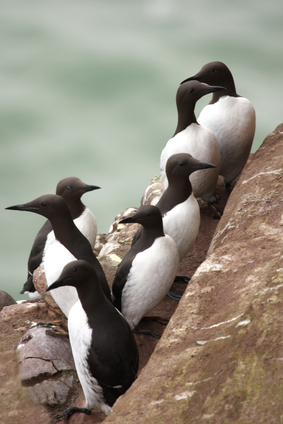An Interview with Shoshanah Jacobs
 Dr. Shoshanah Jacobs studies knowledge transfer both in biomimetics and pedagogy. Her specific interests in biomimetics lie in the way in which designers approach problems of disciplinarity and how challenges can be overcome. In pedagogy she focuses on techniques to effectively teach process rather than content. She uses her research to inform her teaching in biology at the University of Guelph, (Canada) and thinks that the best learning outcome of all is if students celebrate the wonders of the natural world around them and become life-long learners. Born in Ottawa, Canada, Dr. Jacobs studied at the University of New Brunswick in Saint John and the University of Ottawa.
Dr. Shoshanah Jacobs studies knowledge transfer both in biomimetics and pedagogy. Her specific interests in biomimetics lie in the way in which designers approach problems of disciplinarity and how challenges can be overcome. In pedagogy she focuses on techniques to effectively teach process rather than content. She uses her research to inform her teaching in biology at the University of Guelph, (Canada) and thinks that the best learning outcome of all is if students celebrate the wonders of the natural world around them and become life-long learners. Born in Ottawa, Canada, Dr. Jacobs studied at the University of New Brunswick in Saint John and the University of Ottawa.
What are your impressions of the current state of biomimicry/bio-inspired design?
We've hit a bit of a wall. We’ve aggregated some wonderful examples of biomimetic activity and innovation, we’ve explored their potential and, in some cases, we’ve commercialized it. But we’re reliant mostly upon moments of serendipity or chance partnerships among experts. Through my research I have found a few cases where one example of retroactive identification of a biological model has lead to subsequent technologies that do begin with biology. I'd like to investigate these in more depth. For example, this case, and several others have lead me to think that the distinction between problem and solution derived processes is largely artificial and is likely more of a connected double loop. A problem derived process becomes solution derived once a suitable model is found; and a solution derived becomes problem derived once a model is discarded. I think that we are in many cases trying to apply too much vocabulary to concepts and spending a bit too much time on definitions.
This last statement makes me laugh because I just wrote a paper on these topics!
 What do you see as the biggest challenges?
What do you see as the biggest challenges?
It is a challenge of trans-disciplinary knowledge transfer. This is nothing new but it is multi-faceted and still trans-disciplinary thinking and research is underfunded not at all encouraged, where a biologist who publishes a paper in an engineering journal is left to wonder whether that will 'count'. A wonderful opportunity exists to not only elucidate the difficulties specific to biomimetics but also to other fields. A wonderful ‘natural’ laboratory is created every time a team of designers gather together to solve a problem.
The challenge to studying them is also that of confidentiality and patent protection. The drive to commercialize closes the doors to researchers interested in studying the biomimetic process. Trust is needed. I've been quite successful so far due to some very enthusiastic and supportive designers and my willingness to negotiate terms. This last year of research has been so exciting and I am eager to continue.
 What areas should we be focusing on to advance the field of biomimicry?
What areas should we be focusing on to advance the field of biomimicry?
We need to allow for a small group of researchers to research the designers. The benefits are huge:
- the development of a rigorous method for biomimetics that will push the field forward and create possibilities for disruptive innovation
- the introduction of resilience within biomimetic institutions in that not only are they supporting individual projects, but the institution itself is also engaged in knowledge generation
How have you developed your interest in biomimicry/bio-inspired design?
I’ve developed my interest by creating a network of colleagues from many sectors with whom I share ideas. I’ve realized that this type of activity needs to happen as frequently as possible. Only the best ideas come from a session of debate and friendly banter. Nothing can (or should) be done by one’s self. I also have so much data and so little time! Other researchers have expressed interest in working with my data with questions from their discipline, for example. This is the most exciting thing of all!
 What is your best definition of what we do?
What is your best definition of what we do?
We make the wonders of biology useful to us. That's perhaps what we do.
But this will change in the future: Unfortunately, I think that what we do will become absolutely necessary as certain natural services need to be replaced with technology.
By what criteria should we judge the work?
Well this is a bit of tricky one because my work is currently tackling this problem. So my tongue-in-cheek answer is: by mine!
But seriously: we need a solid foundation built upon a scientific framework that will allow the growth of the field.
Many involved in the field use the filter of sustainable development at the point of entry. I think that this is narrow in vision. I also question our ability to accurately identify criteria of sustainability and I therefore question the wisdom of using this as the decider. Sustainable development is an important endpoint: the best, in fact. But it should not determine the trajectory of biomimetics. This is my gut feeling and more research is forthcoming.
What are you working on right now?
I’m interested in many aspects of the process of knowledge transfer. How do experts from other fields approach biology? How do they perceive questions of scale? What are their entry points? What are the appropriate questions of scale? Where does development fail? How can we document the failures? Where does the potential lie? Are we working to that potential? How can we ‘talk’ about biomimetics? How can we realistically make innovations in biology available for study outside of the field? Can we learn something about the biology during the development process that can be transferred back?
 How did you get started in biomimicry/bio-inspired design?
How did you get started in biomimicry/bio-inspired design?
A small bird told me about the idea! I was studying arctic seabirds during the breeding season. I saw their decision making related to changes in prey availability as a reaction to changes in supply relative to demand. Climate change was, essentially, an economic crisis from the bird’s perspective.
I wanted to study this but was told that this was a question outside of my discipline. A chance meeting with a member of Biomimicry Europa convinced me that there is indeed a venue for these types of approaches. And so it all began.
Which work/image have you seen recently that really excited you?
Right now I'm pretty excited about the work being done on understanding process. I think that it is all really innovative and that it also demonstrates some of the challenges that we have to address as we continue along this research path. It's a kind of mish-mash among engineering, pedagogy, psychology, anthropology, and biology. And I'm sure that I've missed a discipline or two in this list.
What is your favorite biomimetic work of all time?
My favourites at this moment are the ones that are being ‘sold’ as biomimicry but aren’t. So I would rather not mention them specifically. The exercises in logic and the discussions that have come from them with my colleagues have been delightful. Stand by though, for the article that is currently being drafted on this issue. As I continue to investigate these cases, I've come to realise that sometimes the goal of 'develping something biomimetic' gets in the way of developing something sustainable, for example. Sometimes the biomimetic component of that innovation is actually less sustainable. I am eager to continue my research on this aspect.
What is the last book you enjoyed?
I really enjoyed The world until yesterday By Jared Diamond.
Who do you admire? Why…
I admire anyone that can check their ego at the door in favour of collectively coming to the best solution. This takes incredible courage.
What’s your favorite motto or quotation?
“I am currently unsupervised. I know, it freaks me out too. But the possibilities are endless.”
 What is your idea of perfect happiness?
What is your idea of perfect happiness?
Being in a large classroom full of enthusiastic minds.
If not a scientist/designer/educator, who/what would you be?
Arthur Dent.
Image Credits:
- On Air: © frank peters - Fotolia.com
- Kingfisher: © Marek Cech - Fotolia.com
- Bullet Train: © photoclicks - Fotolia.com
- thistle: © Andrey Bolovintsev - Fotolia.com
- Guillemots: © ewanc - Fotolia.com
